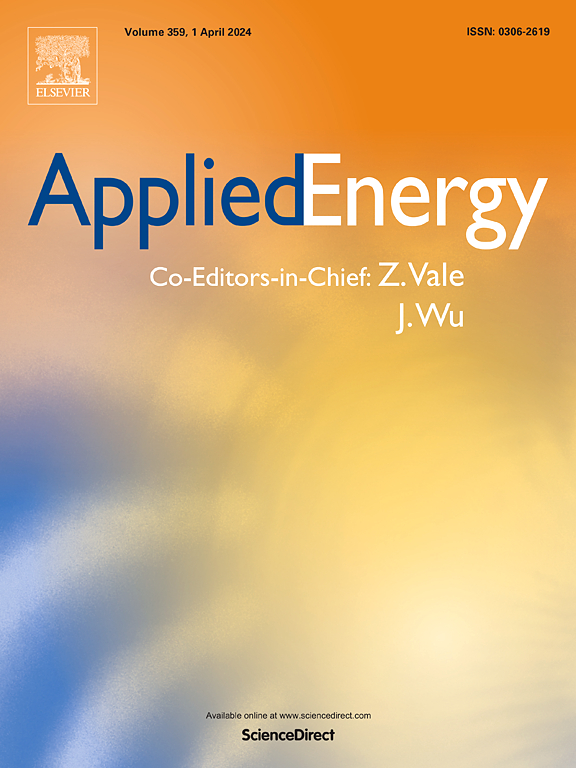Feasibility assessment of e-methanol value chains: Temporal and regional renewable energy, costs, and climate impacts
IF 11
1区 工程技术
Q1 ENERGY & FUELS
引用次数: 0
Abstract
A power-to-X economy can provide low-carbon alternatives to a fossil-based economy, thereby mitigating climate change. E-methanol is a potential alternative but is currently not economically feasible, mainly due to the cost of hydrogen production. Other factors impacting feasibility include the source of carbon dioxide, storage, investment time, capital cost and regulation. Furthermore, multiple industrial operators need to establish a power-to-X value chain, all seeking profitable business opportunities. A cross-disciplinary study was conducted to analyse the influence of these different factors on economic and environmental feasibility. Dynamic modelling was used to optimize e-methanol production based on variable renewable energy generation. Life cycle assessment and costing were used to compare the economic and environmental sustainability of the studied value chains. Over 30-years, the discounted net cash flow of a value chain can become profitable with sufficiently low electricity prices (less than 37€/MWh) and considerable investment subsidies for hydrogen producer. Similar profitability can be achieved with the electricity price given and without subsidies when the weighted average cost of capital is low (5 %). Therefore, hydrogen producers may face challenges in generating profit; highlighting the need for profit-sharing in the value chain and/or subsidies. As capital expenditure for certain technologies is predicted to decline, gradually increasing the production capacity with timed investments is preferable. However, trade-offs may arise in climate change mitigation if investments in cleaner alternatives are delayed.

电子甲醇价值链的可行性评估:时间和区域可再生能源、成本和气候影响
电力到x的经济可以为化石燃料经济提供低碳替代品,从而减缓气候变化。e -甲醇是一种潜在的替代品,但目前在经济上不可行,主要是由于制氢的成本。其他影响可行性的因素包括二氧化碳的来源、储存、投资时间、资本成本和监管。此外,多个工业运营商需要建立一个power-to-X价值链,所有人都在寻找有利可图的商业机会。我们进行了一项跨学科研究,以分析这些不同因素对经济和环境可行性的影响。基于可变可再生能源发电,采用动态建模优化e-甲醇生产。使用生命周期评估和成本计算来比较所研究价值链的经济和环境可持续性。在30年的时间里,如果电价足够低(低于37欧元/兆瓦时),并为制氢企业提供可观的投资补贴,那么价值链的贴现净现金流就可以实现盈利。当加权平均资本成本较低(5%)时,在给定电价和不补贴的情况下也可以实现类似的盈利能力。因此,氢气生产商在产生利润方面可能面临挑战;强调价值链中利润分享和/或补贴的必要性。由于某些技术的资本支出预计将下降,因此最好是通过定时投资逐步提高生产能力。然而,如果推迟对清洁替代品的投资,可能会在减缓气候变化方面产生权衡。
本文章由计算机程序翻译,如有差异,请以英文原文为准。
求助全文
约1分钟内获得全文
求助全文
来源期刊

Applied Energy
工程技术-工程:化工
CiteScore
21.20
自引率
10.70%
发文量
1830
审稿时长
41 days
期刊介绍:
Applied Energy serves as a platform for sharing innovations, research, development, and demonstrations in energy conversion, conservation, and sustainable energy systems. The journal covers topics such as optimal energy resource use, environmental pollutant mitigation, and energy process analysis. It welcomes original papers, review articles, technical notes, and letters to the editor. Authors are encouraged to submit manuscripts that bridge the gap between research, development, and implementation. The journal addresses a wide spectrum of topics, including fossil and renewable energy technologies, energy economics, and environmental impacts. Applied Energy also explores modeling and forecasting, conservation strategies, and the social and economic implications of energy policies, including climate change mitigation. It is complemented by the open-access journal Advances in Applied Energy.
 求助内容:
求助内容: 应助结果提醒方式:
应助结果提醒方式:


